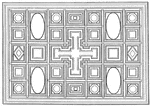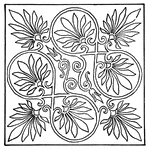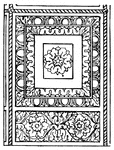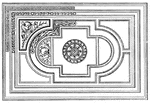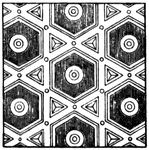Ceilings
The Ceilings ClipArt gallery provides 21 examples of ceiling forms and decoration from various regions and time periods.

Roman Ceiling Panels
A coffer in architecture, is a sunken panel in the shape of a square, rectangle, or octagon in a ceiling,…

Fresco Ceiling
"A Fresco is a kind of painting performed on fresh plaster, or on a wall covered with mortar not quite…

Fresco Ceiling
"The subjects beginning at the top and going to the right are (1.) The paraiytle carrying his bed; (2.)…

Fresco Ceiling
"The subjects, begining at the bottom and going to the right, are (1.) Moses striking the rock; (2.)…

The House of Commons Interior in the Early 20th Century
The interior of the House of Commons in Parliament during the 1900's. It is pictured packed with representatives.…
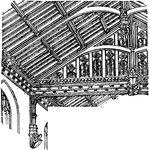
Roof of Nave, St. Mary's, Westonzoyland
The English treated woodwork with consummate skill. They invented and developed a variety of forms of…
![The Palace of Versailles, or simply Versailles, is a royal château in Versailles, the île-de-France region of France. In French, it is known as the Château de Versailles."It was principally the above-mentioned system of Roccoco decoration and architectural detail which characterized the architecture of the time of Louis XV.; it is, consequently, sometimes designated as the style of Louis XV. [This image] gives a portion of an interior drawn in perspective.""Internal arrangement and decoration are the main characteristics of the style of this period, and in this direction the best results were doubtless produced. Large and lofty rooms, as well as scope for display, were indispensable; consequently this style of embellishment was most happily carried out in each state apartments, especially in the princely castles and palaces, or, as the French call them, the "Hôtels" of the aristocracy."](https://etc.usf.edu/clipart/73700/73749/73749_versailles_mth.gif)
Saloon in the Palace of Versailles
The Palace of Versailles, or simply Versailles, is a royal château in Versailles, the île-de-France…

Pantheon
"The finest monument of this time is the Pantheon of Rome, first built about B.C. 27, which is one of…
!["The decoration of the interiors of the buildings of the Renaissance is also copied from ancient Roman architecture. The rooms are either vaulted or have flat ceilings, but in both cases are adorned with paintings after the manner of those discovered in the Baths of Titus, as is shown in [this image], or by panel-work, that is, sunken coffers with a regularly distributed enrichment. These panels are themselves often adorned with historical or allegorical paintings, or with arabesques. Ornamented panels were employed in large palaces for horizontal ceilings, as also in churches, though in the latter case they were more often applied to cupola vaulting, as notable in St. Peter's."](https://etc.usf.edu/clipart/73700/73707/73707_florentine_mth.gif)
Painted Vault of the Florentine Palace in Rome
"The decoration of the interiors of the buildings of the Renaissance is also copied from ancient Roman…
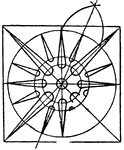
Greek Square Panel
The Greek square panel is found on the coffer of the Propylaea ceiling, the entrance to the Acropolis…
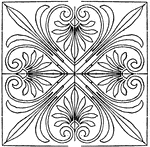
Greek Square Panel
The Greek square panel is found on the coffer of the Propylaea ceiling, the entrance to the Acropolis…
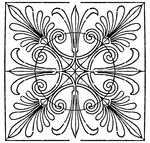
Greek Square Panel
The Greek square panel is found on the coffer of the Propylaea ceiling, the entrance to the Acropolis…
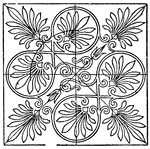
Greek Square Panel
The Greek square panel is found on the coffer of the Parhtenon ceiling, a Greek Temple. This panel is…


